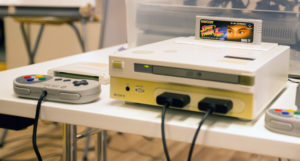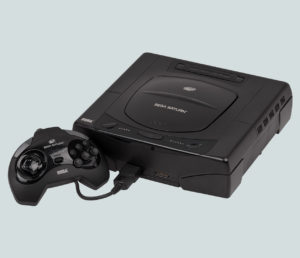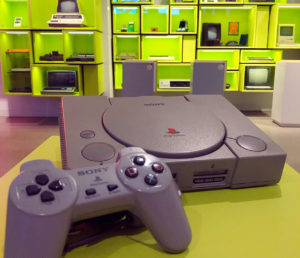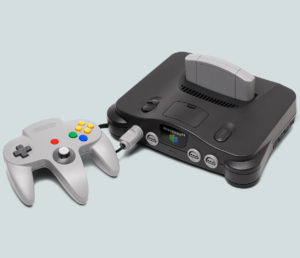
Wikimedia / Mats Lindh
A piece of video game history hits the auction block
In March 2020, a legendary prototype will be going under the hammer: the Nintendo PlayStation was introduced in 1991, but never made it to market.
It’s nothing new for one-of-a-kind video games, rarities still in their original packaging, historic hardware or gaming machines produced in limited quantities to change hands for what are sometimes exorbitant prices. But a very special item is currently being auctioned off by online auction house Heritage Auctions, which specialises in, among other things, comics and video games. The prototype of the Nintendo PlayStation (Nintendo PlayStation Super NES CD-ROM) is perhaps the last specimen of a console that was never released, the product of a failed collaboration between Nintendo and Sony. Both the device’s background and its unexpected rediscovery are worthy of a movie in their own right.

Reproduction of a child’s bedroom from the 1980s.
Computerspielemuseum Berlin
An innovation-hungry market
In the late 1980s the video arcades were booming, the Commodore 64, the Amstrad CPC and the Sinclair ZX Spectrum were the most popular home computers, and three Japanese firms shared the console market: Nintendo, Sega and NEC.
Nintendo launched its first console on the Japanese market in 1983, under the name Famicom. Two years later, the device went on sale worldwide as the Nintendo Entertainment System (NES). While Sega in particular, with its Mega Drive (known in the USA as Sega Genesis), was a strong competitor for Nintendo internationally, NEC’s PC Engine (TurboGrafx 16 in the USA) dominated the Japanese market.
At that time, the data processing media were much more heterogeneous than they are today. While both cassettes and diskettes were common in the home computer sector, the cartridge was the data medium of choice for consoles. So the games for the NES, Mega Drive and PC Engine initially came out on cartridges. To secure more market shares, in 1986 Nintendo released an add-on for the Famicom, allowing 3-inch diskettes also to be used as data media. Its competitor NEC, meanwhile, was devoting itself to a new technology. From 1988 a CD-ROM drive was offered as an add-on for the PC Engine, and the competition was finally left behind, within Japan at any rate. In 1989 NEC’s successor console SuperGrafx, exclusive to Japan, followed; like later versions of the PC Engine, the SuperGrafx featured a CD-ROM drive as standard.

Prototype of the Nintendo PlayStation.
Wikimedia / Mats Lindh
Between cartridge and future
Nintendo then turned to Sony. At that time, the electronics company was already working on a sound chip for Nintendo’s next console, the Super NES. In addition, the plan was now to develop a CD-ROM drive that would make the Super NES competitive. In return, Nintendo wanted to make its own cartridge technology available to its partner Sony. Both companies would then have been able to produce consoles that could read both cartridges and CD-ROMs. Sony was not actually interested in entering the console business at the time, but agreed.
The Super NES (Super Famicom in Japan) was launched worldwide between 1990 and 1992. The prototype, which had meanwhile been created in Sony’s laboratories, was first introduced to the public in 1991 under the name PlayStation. However, the creamy white, rectilinear box with cartridge and CD drive, as well as digital display and adapted Super NES controller, was destined never to storm the sales shelves.
Nintendo unexpectedly announced soon after that it planned to work with Sony’s competitor Philips on the development of a CD-ROM drive for the Super NES. But Philips ended the collaboration, so Nintendo’s Super NES ultimately never got a CD-ROM add-on. As a result of this involuntary change of course the successor console, the Nintendo N64, was still a cartridge console with no optical drive when it came out in 1996. In 1991 competitor Sega released the Sega Mega-CD, a CD-ROM drive for the Mega Drive, and then the Sega Saturn with optical drive in 1994.
Sony also continued to develop the existing technology. In 1994 the Sony PlayStation with optical drive was launched in Japan, and hit the international market in late summer 1995. With more than 100 million devices sold, it’s still one of the most successful consoles of all time.

The Sega Saturn console with optical drive in 1994.
Wikimedia

A Sony PlayStation from 1995 in the Computerspielemuseum in Berlin.

The involuntary change of course resulted in the Nintendo N64 being released in 1996 without an optical drive.
Wikimedia
An unexpected attic find
It’s almost a miracle that the legendary prototype has finally seen the light of day again. The current owner and seller, Terry Diebold, had unwittingly bought the device together with other ‘junk’ more than ten years ago. It wasn’t until 2015 that Diebold’s son discovered the device in the attic and then told people about it online. In the years following, Diebold and his son presented the Nintendo PlayStation at numerous trade shows around the world. Now the device is being sold. The reserve price of 15,000 US dollars has already been surpassed many times over. The current bid is 280,000 US dollars. The price at which the Nintendo PlayStation finally moves to a new home will be revealed on 6 March, when the auction ends.
EDIT: The device was sold on March 6, 2020 for $ 360,000.



